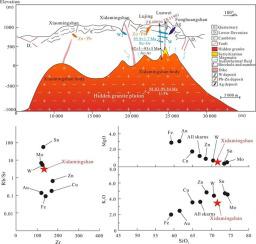Ore Geology Reviews ( IF 3.2 ) Pub Date : 2020-12-30 , DOI: 10.1016/j.oregeorev.2020.103932 Yangyang Feng , Wei Fu , Zuohai Feng , Jianwen Yang , Zhongyang Li , Xingwen Le , Saisai Li , Meng Feng , Chunzeng Wang , Jifeng Xu

|
Common understanding of pluton-related W-polymetallic mineralization is mainly based on studies in areas with exposed granitic plutons or plutons buried at shallow levels. However, there exist a large number of ore deposits that are considered to be associated with deeply hidden granitic plutons (deeper than 500 m). Their metallogenesis is not well documented due to lack of deep drilling and sampling. In this paper, we present a deeply hidden granitic pluton recently discovered by a kilometer-scale drilling project in the Xidamingshan Mountains area in western South China. The pluton, here refereed to Xidamingshan granitic pluton, underlies the Xidamingshan W-Zn-Pb-Ag-mineralized district. Petrographic examinations reveal that the hidden granite is biotite granite with partly hydrothermal alteration and that the upper part of the pluton is subjected to greisenization. Geochronological analyses indicate that the granite pluton was emplaced at the Late Cretaceous time with zircon U-Pb ages of 98.0 ± 1.0 Ma and 99.8 ± 0.9 Ma. The emplacement was subsequently followed by hydrothermal activity as indicated by muscovite 40Ar-39Ar ages of 93 ± 3 Ma and 92 ± 3 Ma. Re-Os dating of molybdenite yields an isochronal age of 95.9 ± 1.7 Ma (MSWD = 2.2). These ages indicate that the Xidamingshan mineralization is temporally related to the hidden granite. The granite is strongly peraluminous (A/CNK = 1.50 – 1.61) with high-K calc-alkaline affinity (ASI = 1.46 – 1.61) and shows enrichment in Rb, Ta, U, and K and depletion in Nb, P, and Ti. It contains muscovite and biotite but is lack of hornblende. It shows a steady correlation between P2O5 and increasing SiO2, high Rb/Sr ratios (1.33 – 3.12), and high zirconium saturation temperature (average of 767 °C). The Xidamingshan granite is thus a typical S-type granite. Geochemical signature and negative εHf(t) values (-4.9 – −12.6) indicate that the hidden granite might have been generated by melting of crustal materials of argillaceous-depleted sedimentary rocks. Granites with such geochemical characteristics are known as having W-polymetallic mineralization specialization based on comparison with other ore-forming granites in South China. Significant W-polymetallic mineralization has been found within the thick Cambrian strata overlying the hidden granite pluton. Distribution of the related deposits demonstrates a typical zoning pattern from skarn-type W deposits, through vein-type Pb-Zn deposits, to vein-type Ag deposits. Given the combined evidences of metallogenic specialization of the source rocks for granitic magmas, geochronological coupling of the magmatism and hydrothermal activity, and the hydrothermal alteration and mineralization zoning, it is suggested that there exists a hydrothermal W-Zn-Pb-Ag mineralization system driven by the emplacement of the Late Cretaceous S-type hidden granite pluton. The findings of this study provide insights into future deep drilling and related ore exploration in regions with hidden granite in South China and the world.










































 京公网安备 11010802027423号
京公网安备 11010802027423号